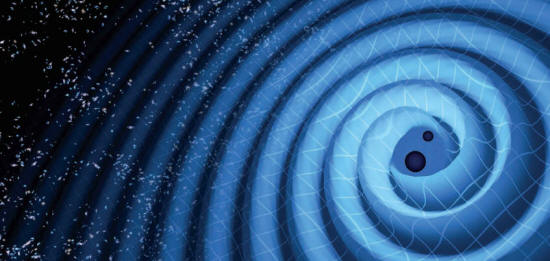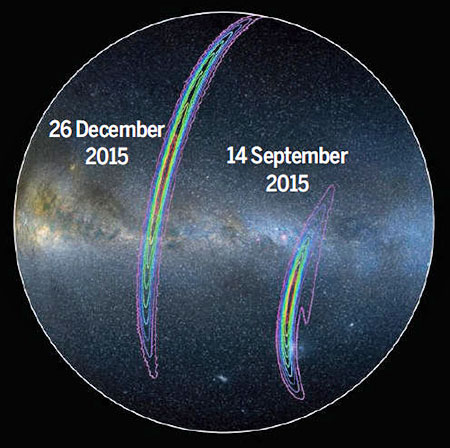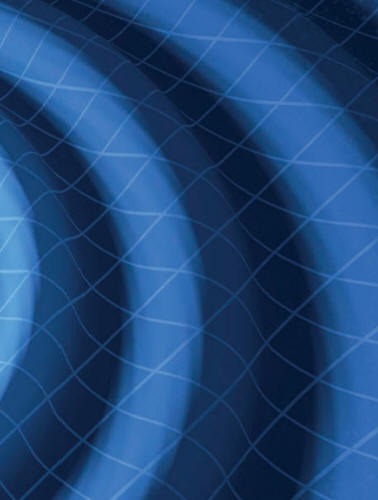|
from
Sci-Hub Website
augurs bumper crop of sightings
For a second time, physicists working with the two massive detectors in the Laser Interferometer Gravitational-Wave Observatory (LIGO) have detected a pulse of such waves, the LIGO team reported on 15 June at a meeting of the American Astronomical Society in San Diego, California.
Once again the waves emanated from the merger of two black holes, the ultra-intense gravitational fields left behind when massive stars collapse into infinitesimal points.
The new observation suggests that after fine-tuning, LIGO will spot dozens or even hundreds of the otherwise undetectable events each year.
Cole Miller, an astrophysicist at the University of Maryland, College Park, who is not a member of the collaboration, says that the new find shows that LIGO,
Astrophysicists' catalog of stellar-mass black holes, he says,
The new observation came at 3:38.53 Coordinated Universal Time on 26 December 2015 - late on Christmas day at LIGO's detectors in Livingston, Louisiana, and Hanford, Washington.
As in the first event, the detectors sensed an oscillating stretching of space-time, the signal, according to Einstein's general theory of relativity, of massive objects in violent motion.
Computer modeling indicated that its
source was two black holes spiraling together about 1.4 billion
light-years away. (LIGO researchers had seen a weaker signal on 12
October 2015 that may be a third black hole merger.)
The purple and yellow
lines define the likely signal source regions.
It lasted only 0.2 seconds, and physicists glimpsed only the last 10 cycles of the black holes' spiraling motion before their collision.
The December 2015 sighting involved
smaller black holes, 14 and 7.5 times as heavy as the sun.
Physicists witnessed 55 cycles of the death spiral, a full second.
Astrophysicists don't know how such jumbo black holes formed.
The black holes in the new event,
Nevertheless, the latest event yields new insights.
For example, physicists determined that one of the black holes was spinning frenetically, at roughly 20% of the maximum spin rate allowed by general relativity.
And because the new event includes many
more cycles, it tests predictions of general relativity somewhat
more stringently than the first event, Gabriela Gonzalez says.
(Einstein's theory passes the test.)
Rebuilt from 2010 to 2015, the new LIGO detectors have not yet reached their design sensitivity.
On 26 December 2015, LIGO detected gravitational waves from two black holes spiraling together.
If they do, they should see as many as one black hole merger per day, estimates Stephen Fairhurst, a gravitational-wave astrophysicist and LIGO team member at Cardiff University in the United Kingdom.
The resulting sample should lay bare the
mysterious evolution of black hole binaries, he says, showing
whether they start out as pairs of stars that turn into black holes
or as black holes that form independently and ultimately find each
other.
David Reitze, LIGO's executive director at the California Institute of Technology in Pasadena, says he's cautiously optimistic that physicists can eliminate the noise and reach design sensitivity by 2019.
Physicists hope LIGO will eventually detect waves from other kinds of cosmic collisions.
Mergers involving neutron stars, for example, would plumb the mysterious physics of these objects, which are essentially gigantic atomic nuclei with masses between 1.5 and three times that of the sun.
LIGO physicists are combing their data
for such signals, but finding them is a long shot at the present
sensitivity, Gonzalez says.
The detectors, now restarting after tune-ups, are expected to begin a second data run this fall. They should also be joined by the revamped VIRGO detector, an interferometer near Pisa, Italy, that will help pinpoint sources in the sky and measure their distances.
LIGO may well have more surprises in store, Sebastian Heinz says:
|




